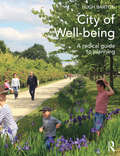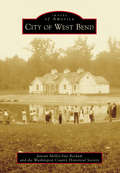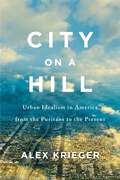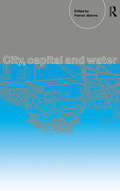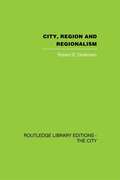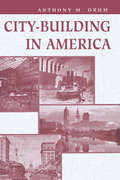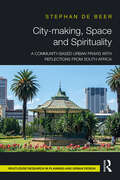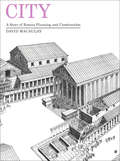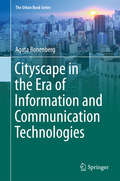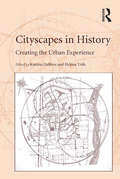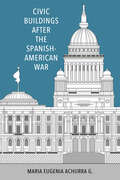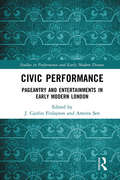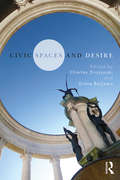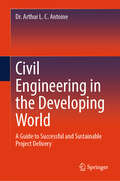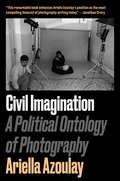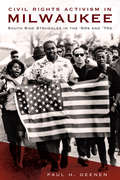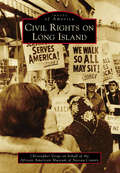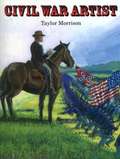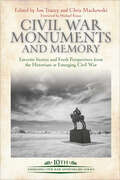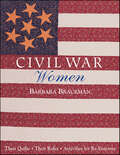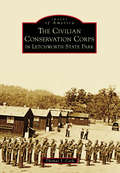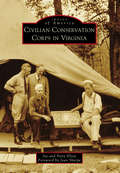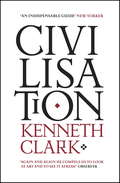- Table View
- List View
City of Well-being: A radical guide to planning
by Hugh BartonCity of Well-being provides a radical and holistic introduction to the science and art of town planning. It starts from the premise that the purpose of planning is the health, well-being and sustainable quality of life of people. Drawing on current and historic examples it offers inspiration, information and an integrated perspective which challenges all professions and decision-makers that affect the urban environment. It is both authoritative and readable, designed for students, practitioners, politicians and civil society. The science. Summarizing the most recent research, the book demonstrates the interrelationships between the huge issues of obesity, unhealthy lifestyles, inequality, mental illness, climate change and environmental quality. The radical implications for transport, housing, economic, social and energy policies are spelt out. The art and politics. The book examines how economic development really happens, and how spatial decisions reinforce or undermine good intentions. It searches for the creative strategies, urban forms and neighbourhood designs that can marry the ideal with the real. The relationship of planning and politics is tackled head-on, leading to conclusions about the role of planners, communities and development agencies in a pluralistic society. Healthy planning principles could provide a powerful logical motivation for all practitioners.
City of West Bend
by Janean Mollet-Van Beckum Washington County Historical SocietyThe City of West Bend got its name from its location on a large westward-reaching bend of the Milwaukee River. Settled mainly by German immigrants in the 1840s, the city was bestowed with leaders possessing entrepreneurial know-how. West Bend became an international center of manufacturing with companies such as the West Bend Aluminum Company, Enger-Kress Pocket Book Company, and Gehl Brothers Manufacturing. Knowing how to work hard, West Bend's residents also played hard with a booming downtown area, local sports teams, parks, and cultural entertainment. Recent decades have seen a decline of local industry, but unlike many communities, the historic downtown continues to thrive with shops, restaurants, and lively cultural offerings. Home to unique architecture such as Old Courthouse and Jail, beautiful Victorian homes, and the new Museum of Wisconsin Art, West Bend continues to thrive and take pride in its past while looking to the future.
City on a Hill: Urban Idealism in America from the Puritans to the Present
by Alex KriegerFrom the pilgrims to Las Vegas, hippie communes to the smart city, utopianism has shaped American landscapes. The Puritan small town was the New Jerusalem. Thomas Jefferson dreamed of rational farm grids. Reformers tackled slums through crusades of civic architecture. To understand American space, Alex Krieger looks to the drama of utopian ideals.
City, Capital and Water
by Patrick MaloneThe urban waterfront is widely regarded as a frontier of contemporary urban development, attracting both investment and publicity. City, Capital and Water provides a detailed account of the redevelopment of urban waterfronts in nine cities around the world: London, Tokyo, Kobe, Osaka, Hong Kong, Sydney, Toronto, Dublin and Amsterdam. The case studies cover different frameworks for development in terms of the role of planning, approaches to financing, partnership agreements, state sponsorship and development profits. The analysis also demonstrates the effects of economic globalization, deregulation, the marginalization of planning and the manipulation of development processes by property and political interests.
City, Region and Regionalism: A geographical contribution to human ecology
by Robert E. DickinsonThis book was first published in 1947.
City-building In America
by Anthony M OrumWhy do some cities grow and expand, while others dwindle and decline? Why is Milwaukee a town of the past, while Minneapolis seems reborn and infused with fture dynamism? And what do Milwaukee and Minneapolis have to tell us about other cities' prospects, the trials and destinies of industrial Cleveland and post-industrial Austin? Anthony Orum's book tells the story of these cities and, at the same time, of all cities. Here the urban past, present and future are woven into one tale. Orum traces the shift in the sources of urban growth from entrepreneurs to institutions and highlights the emergence of local government as a prominent force - indeed, as an institution - in shaping the trajectory of the urban industrial heartland. This complex trajectory includes all aspects of urban boom and bust: population trends, economic prosperity, politics and culture, as well as hard-to-pin-down qualities lika a city's collective hope and vision. Interspersing social theory, historical ethnography and comparative analysis to help explain the fates of different cities, Orum portrays factory openings, labour strikes, elections, evictions, urban blight, white flight, recession and rejuvenation to show the core histories - and future shape - of cities beyond the particulars presented in these pages. The reader should discover the key people and politics of cities along with the forces that direct them. With a variety of sources including newspapers, diaries, census materials, maps, photo essays and original oral histories, this book should be useful for anyone interested in urban transformation and for courses in urban sociology, urban politics, industrial sociology, social change and social mobility.
City-making, Space and Spirituality: A Community-Based Urban Praxis with Reflections from South Africa
by Stéphan de BeerThis book is about the soul of the city, embodied in its spaces and people. It traces dynamics in inner city neighbourhoods of South Africa’s post-apartheid capital, Pretoria. Viewing the city through its most vulnerable people and places, it recognizes that urban space is never neutral and shaped by competing value frameworks. The first part of the book invites planners, city-makers, and ordinary urban citizens, to consider a new self-understanding, reclaiming their agency in the city-making process. Through the metaphor of "becoming like children", planning practice is deconstructed and re-imagined. A praxis-based methodology is presented, cultivating four distinct moments of entering, reading, imagining and co-constructing the city. After deconstructing urban spaces and discourses, the second part of the book explores a concrete spirituality and ethic of urban space. It argues for a shift from planning as technocracy, to planning as immersed, participatory artistry: opening up to the "genius" of space, responsive to urban cries, and joining to construct new, soul-full spaces. Local communities and interconnected movements become embodiments of urban alternatives – through resistance and reconstruction; building on local assets; animating local reclamations; and weaving nets of hope that will span the entire city. Providing a concrete methodology for city-making that is rooted in a community-based urban praxis, this book will be of interest to urban planning researchers, professional planners and designers and also grass-root community developers or activists.
City: A Story of Roman Planning and Construction (The\world Around Us Series)
by David MacaulayThe Caldecott Medal-winning author and illustrator takes young readers through the building of an imaginary city in Ancient Rome. In City, David Macaulay introduces readers to the fascinating world of Ancient Roman architecture and engineering, combining straightforward text and black and white illustrations to tell the story of a city&’s creation. While the Roman city of Verbonia is imaginary, its planning and construction are based on those of the hundreds of Roman cities founded between 300 B.C. and 150 A.D. From the process of selecting the ideal site on which to build, Macaulay moves through each phase of the process. &“Engineering, architectural and human details enliven a tour of the completed city—the water supply and drainage system, the forum and central market, the homes of a merchant and a craftsman, the theatre, the public baths&” and much more are intricately imagined, illustrated, and explained (Kirkus).
Cityscape in the Era of Information and Communication Technologies (The Urban Book Series)
by Agata BonenbergThis book discusses the impact of information and communication technologies, particularly social media, on the structure and landscape of contemporary cities. It presents a multidisciplinary range of theories and practical case studies and addresses a broad readership, from graduate students to practitioners active in the fields of urbanism and the architectural design of urban space. The book includes a wealth of illustrations depicting contemporary architecture and exemplary modern public spaces, as well as diagrams and tables that optimally visualize the concepts and ideas discussed.
Cityscapes in History: Creating the Urban Experience
by Heléna TóthCityscapes in History: Creating the Urban Experience explores the ways in which scholars from a variety of disciplines - history, history of art, geography and architecture - think about and study the urban environment. The concept ’cityscapes’ refers to three different dynamics that shape the development of the urban environment: the interplay between conscious planning and organic development, the tension between social control and its unintended consequences and the relationship between projection and self-presentation, as articulated through civic ceremony and ritual. The book is structured around three sections, each covering a particular aspect of the urban experience. ’The City Planned’ looks at issues related to agency, self-perception, the transfer of knowledge and the construction of space. ’The City Lived’ explores the experience of urbanity and the construction of space as a means of social control. And finally, ’The City as a Stage’ examines the ways in which cultural practices and power-relations shape - and are in turn shaped by - the construction of space. Each section combines the work of scholars from different fields who examine these dynamics through both theoretical essays and empirical research, and provides a coherent framework in which to assess a wide range of chronological and geographical subjects. Taken together the essays in this volume provide a truly interdisciplinary investigation of the urban phenomenon. By making fascinating connections between such seemingly diverse topics as 15th century France and modern America, the collection raises valuable questions about scholarly approaches to urban studies.
Civic Buildings after the Spanish-American War (Caribbean Studies Series)
by Maria Eugenia Achurra G.Following the 1898 Spanish-American War, the United States constructed federal buildings in its newly acquired territories, including Cuba, Puerto Rico, and the Philippines. Over a century later, many of these grand Beaux-Arts-style edifices are still in use. In Civic Buildings after the Spanish-American War, Maria Eugenia Achurra G. examines this architecture and urban design as a backdrop for US exceptionalism and expansionism.The book defines exceptionalism and its role in US Beaux-Arts federal architecture. Subsequent chapters compare specific examples of Beaux-Arts civic architecture in the continental US and Latin America. The book also studies architectural and urban design from other US possessions of the Progressive Era, such as the former Panama Canal Zone and occupied territories like the Dominican Republic. Reviewing the work of relevant designers and architects, Achurra G. argues that architectural examples epitomize the rich, expansionist intentions of twentieth-century Progressive America. These lingering buildings function as intriguing material evidence of the United States’ geopolitical, historical, and commercial meddling in the internal affairs of the Americas and elsewhere.
Civic Monuments and the Augustales in Roman Italy
by Margaret L. LairdThe combination of portrait statue, monumental support, and public lettering was considered emblematic of Roman public space even in antiquity. This book examines ancient Roman statues and their bases, tombs, dedicatory altars, and panels commemorating gifts of civic beneficence made by the Augustales, civic groups composed primarily of wealthy ex-slaves. Margaret L. Laird examines how these monuments functioned as protagonists in their built and social environments by focusing on archaeologically attested commissions made by the Augustales in Roman Italian towns. Integrating methodologies from art history, architectural history, social history, and epigraphy with archaeological and sociological theories of community, she considers how dedications and their accompanying inscriptions created webs of association and transformed places of display into sites of local history. Understanding how these objects functioned in ancient cities, the book argues, illuminates how ordinary Romans combined public lettering, honorific portraits, emperor worship, and civic philanthropy to express their communal identities.
Civic Performance: Pageantry and Entertainments in Early Modern London (Studies in Performance and Early Modern Drama)
by J. Caitlin Finlayson Amrita SenCivic Performance: Pageantry and Entertainments in Early Modern London brings together a group of essays from across multiple fields of study that examine the socio-cultural, political, economic, and aesthetic dimensions of pageantry in sixteenth and seventeenth-century London. This collection engages with modern interest in the spectacle and historical performances of pageantry and entertainments, including royal entries, progresses, coronation ceremonies, Lord Mayor’s Shows, and processions. Through a discussion of the extant texts, visual records, archival material, and emerging projects in the digital humanities, the chapters elucidate the forms in which the period itself recorded its public rituals, pageantry, and ephemeral entertainments. The diversity of approaches contained in these chapters reflects the collaborative nature of pageantry and civic entertainments, as well as the broad socio-cultural resonances of this form of drama, and in doing so offers a study that is multi-faceted and wide-ranging, much like civic performance itself. Ideal for scholars of Early Modern global politics, economics, and culture; literary and performance studies; print culture; and the digital humanities, Civic Performance casts a new lens on street pageantry and entertainments in the historically and culturally significant locus of Early Modern London.
Civic Spaces and Desire
by Charles Drozynski Diana BeljaarsCivic Spaces and Desire presents an original and critical appraisal of civic spaces for a novel theoretical intersection of architecture and human geography. The authors address civic spaces that embody a strong moral code, such as a remembrance park or a casino, in various places in the United Kingdom, Europe, North America, Australia and Asia. The consecutive chapters of the book present these chosen spaces as the interconnection between the everyday and the ideological. By doing so the book reimagines the socio-political effects of the countercultural assemblages and ontologies of difference that these spaces produce, represent and foster, as presented through outcasts and nomads of various kinds and forms. The book reflects on different interpretations of the key texts from primarily post-linguistic theoreticians, such as Gilles Deleuze, Félix Guattari and Jacques Derrida. It will benefit students and academics in architecture, geography, philosophy and urban studies and planning, who seek to understand the politics of space, place and civility. By deconstructing normative ideological constructs, the book uses the concept of desire to explore the tensions between expectations of civic spaces and the disappointment and wonder of their immanent existence. Chapter 1 of this book is freely available as a downloadable Open Access PDF at http://www.taylorfrancis.com under a Creative Commons Attribution-Non Commercial-No Derivatives (CC-BY-NC-ND) 4.0 license.
Civil Engineering in the Developing World: A Guide to Successful and Sustainable Project Delivery
by Dr. Arthur L. C. AntoineThis book provides a pragmatic roadmap for mastering project delivery in civil and infrastructure engineering—one that applies across both developing and industrialized nations. Dr. Arthur L.C. Antoine, an experienced civil engineer, project manager, and researcher, blends real-world case studies with empirical data to scrutinize current project delivery methods and performance. With a focus on the foundational pillars of schedule, cost, and quality—alongside the critical but often overlooked elements of procurement and risk—this book offers a fresh perspective for industry professionals, policymakers, and stakeholders. Through practical insights and rigorous analysis, Dr. Antoine challenges conventional approaches, highlights global best practices, and presents actionable recommendations for delivering infrastructure projects that are successfully delivered with a focus on long-term transformation. The book is ideal for engineers, project managers, public works leaders, and anyone invested in the future of infrastructure development.
Civil Imagination
by Ariella AzoulayUnderstanding photography is more than a matter of assessing photographs, writes Ariella Azoulay. The photograph is merely one event in a sequence that constitutes photography and which always involves an actual or potential spectator in the relationship between the photographer and the individual portrayed. The shift in focus from product to practice, outlined in Civil Imagination, brings to light the way images can both reinforce and resist the oppressive reality foisted upon the people depicted.Through photography, Civil Imagination seeks out relations of partnership, solidarity, and sharing that come into being at the expense of sovereign powers that threaten to destroy them. Azoulay argues that the "civil" must be distinguished from the "political" as the interest that citizens have in themselves, in others, in their shared forms of coexistence, as well as in the world they create and transform. Azoulay's book sketches out a new horizon of civil living for citizens as well as subjects denied citizenship--inevitable partners in a reality they are invited to imagine anew and to reconstruct.Beautifully produced with many illustrations, Civil Imagination is a provocative argument for photography as a civic practice capable of reclaiming civil power.
Civil Rights Activism in Milwaukee: South Side Struggles in the '60s and '70s
by Paul H. GeenenIn the early 1960s, as members of Milwaukee's growing African American population looked beyond their segregated community for better jobs and housing, they faced bitter opposition from the real estate industry and union leadership. In an era marked by the friction of racial tension, the south side of Milwaukee earned a reputation as a flashpoint for prejudice, but it also served as a staging ground for cooperative activism between members of Father Groppi's parish, representatives from the NAACP Youth Council, students at Alverno College and a group of Latino families. Paul Geenen chronicles the challenges faced by this coalition in the fight for open housing and better working conditions for Milwaukee's minority community.
Civil Rights in Birmingham (Images of America)
by Birmingham Civil Rights Institute Laura Caldell AndersonSince the city's founding in 1871, African American citizens of Birmingham have organized for equal access to justice and public accommodations. However, when thousands of young people took to the streets of Birmingham in the spring of 1963, their protest finally broke the back of segregation, bringing local leadership to its knees. While their parents could not risk loss of jobs or life, local youth agreed to bear the brunt of resistance by law enforcement and vigilantes to their acts of civil disobedience. By the fall, even youth who did not participate in the Children's Movement gave all for the struggle when a bomb placed in the 16th Street Baptist Church exploded and killed four girls.
Civil Rights on Long Island (Images of America)
by African American Museum of Nassau County Christopher Claude VergaLong Island has been in the corridors of almost all major turning points of American history, but Long Island has been overlooked as a battleground of the civil rights movement. Since early colonization by the English settlers in the 17th century, the shadow of slavery has bequeathed a racial caste system that has directly or indirectly been enforced. During World War II, every member of society was asked to participate in ending tyranny within European and Asian borders. Homeward-bound black soldiers expected a societal change in race relations; instead they found the same racial barriers they experienced prior to the war. They were refused homes in developments such as Levittown, denied mortgages, and had their children face limited educational opportunities. Collective efforts from organizations such as Congress of Racial Equality (CORE) and the National Association for the Advancement of Colored People (NAACP) employed civil disobedience as a tactic to fracture racial barriers.
Civil War Artist
by Taylor MorrisonWilliam Forbes arrives in New York in 1861, eager to start a career as an artist. When he has difficulty finding work, he signs on with Burton's Illustrated News to sketch the battles of the Civil War. This historical account shows how the news was reported, from William's sketches of dangerous battle scenes through the making of a wood engraving and finally to the printed page of the newspapers of the day.
Civil War Monuments and Memory: Favorite Stories and Fresh Perspectives from the Historians at Emerging Civil War (Emerging Civil War Series)
by Chris MackowskiThe American Civil War left indelible marks on the country. In the century and a half since the war, Americans have remembered the war in different ways. Veterans placed monuments to commemorate their deeds on the battlefield. In doing so, they often set in stone and bronze specific images in specific places that may have conflicted with the factual historical record. Erecting monuments and memorials became a way to commemorate the past, but they also became important tools for remembering that past in particular ways. Monuments honor, but they also embody the very real tension between history and the way we remember that history—what we now today call “memory.” Civil War Monuments and Memory: Favorite Stories and Fresh Perspectives from the Historians at Emerging Civil War explores some of the ways people monumented and memorialized the war—and how those markers have impacted our understanding of it. This collection of essays brings together the best scholarship from Emerging Civil War’s blog, symposia, and podcast—all of it revised and updated—coupled with original pieces, designed to shed new light and insight on the monuments and memorials that give us some of our most iconic and powerful connections to the battlefields and the men who fought there.
Civil War Women
by Barbara BrackmanNorth and South, black and white - the story of the War Between the States is embedded in the soul of every American. In her second book on quilts and the Civil War, Barbara Brackman introduces 9 women who lived during those turbulent times, matching each woman to a quilt that she might have made herself. • 9 projects adapted from period quilts, with patterns and instructions • Excellent reference book for Civil War re-enactors; offers creative activities related to each woman's story • Fascinating information about 9 real-life American women and their experiences during the Civil War, from abolitionist speaker Lucy Stone to freed slave Susie Taylor King to Confederate spy Belle Edmondson • Make a reproduction quilt and forge a personal link to the women of the Civil War! *Important Note about PRINT ON DEMAND Editions: This title will be printed after purchase and will arrive separately from any in-stock items. Please allow approximately 2 weeks for USA delivery, with an additional 2 weeks for international shipments. Expedited shipping is not available on POD Editions. The printing quality in this copy will vary from the original offset printing edition and may look more saturated due to printing on demand by a high-quality printer on uncoated (non-glossy) paper. The information presented in this version is the same as the most recent printed edition. Any pattern pullouts have been separated and presented as single pages.
Civilian Conservation Corps in Letchworth State Park, The
by Thomas S. CookLetchworth State Park, located in the Genesee Valley of western New York State, is renowned for its natural beauty, scenic roads, trails, and recreational facilities. Created from the private estate of William Pryor Letchworth in 1907, the park quickly grew in size and popularity. A series of ambitious expansion and development plans were under way when the Great Depression struck, threatening the park's future. That future was restored when President Roosevelt's Civilian Conservation Corps brought hundreds of young men to the four CCC camps established in the park. From 1933 to 1941, they worked on cabins, roads, and other projects, while strengthening their bodies, minds, and futures. Their legacy is still enjoyed by thousands of park visitors today. The Civilian Conservation Corps in Letchworth State Park explores the stories of these camps, as well as the CCC "boys" and their legacy, through vintage photographs, camp and area newspapers, official reports, and the memories of CCC veterans.
Civilian Conservation Corps in Virginia (Images of America)
by Joe Foreword By Sharpe Patty EltonIn 1933, the United States was struggling to survive the Great Depression. Pres. Franklin D. Roosevelt promised a “New Deal” to put the nation back to work. The Civilian Conservation Corps (CCC) was launched in Virginia’s Blue Ridge Mountains, where the first camp, Camp Roosevelt, was built. The CCC was widely acclaimed as the most popular of Roosevelt’s programs. In Virginia, CCC workers built Shenandoah National Park, the Blue Ridge Parkway, the first six state parks, and more. Despite the program’s success, senators from Virginia led the Congressional efforts to kill the CCC in 1942.
Civilisation
by Kenneth ClarkKenneth Clark's sweeping narrative looks at how Western Europe evolved in the wake of the collapse of the Roman Empire, to produce the ideas, books, buildings, works of art and great individuals that make up our civilisation.The author takes us from Iona in the ninth century to France in the twelfth, from Florence to Urbino, from Germany to Rome, England, Holland and America. Against these historical backgrounds he sketches an extraordinary cast of characters -- the men and women who gave new energy to civilisation and expanded our understanding of the world and of ourselves. He also highlights the works of genius they produced -- in architecture, sculpture and painting, in philosophy, poetry and music, and in science and engineering, from Raphael's School of Athens to the bridges of Brunel.
